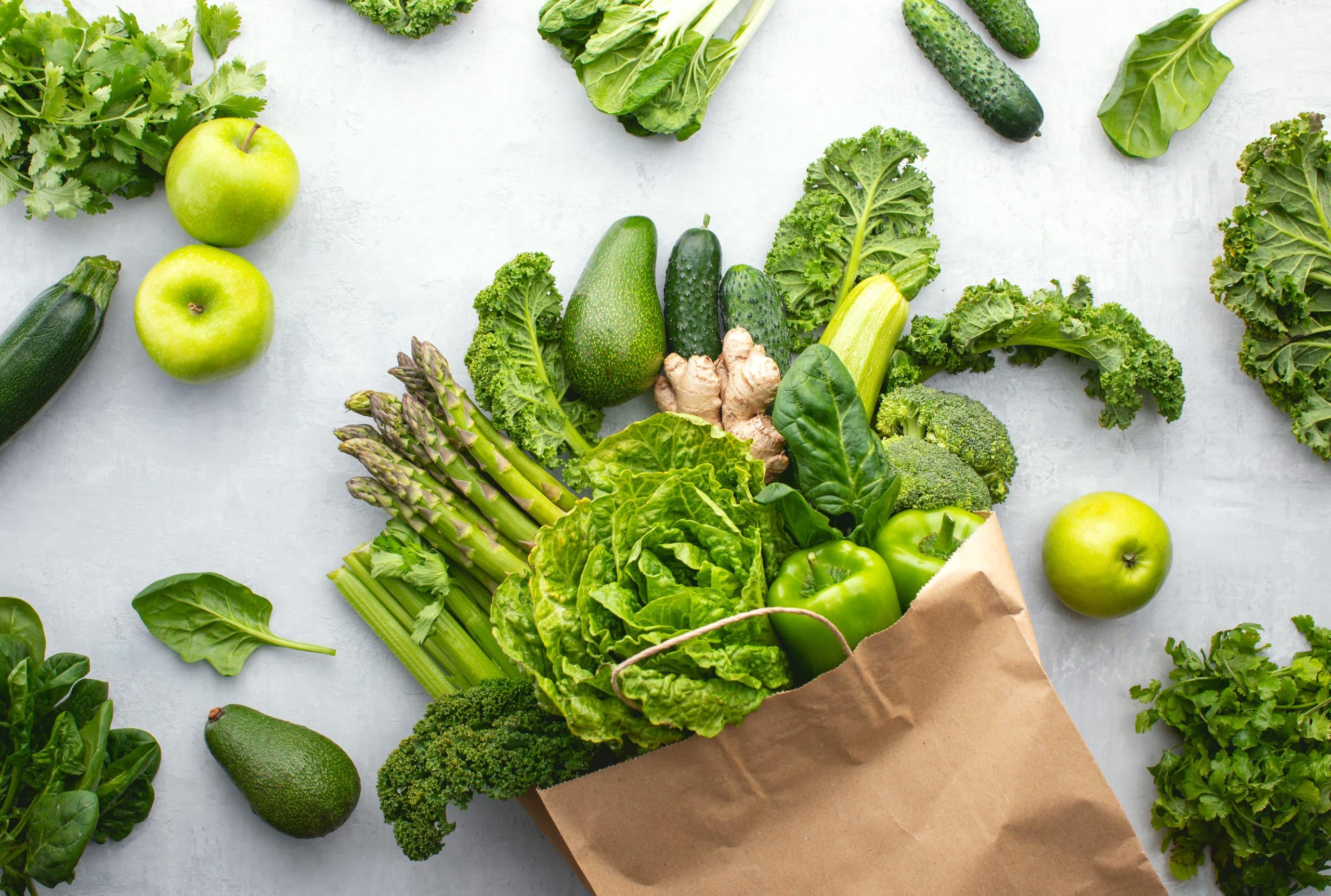Are you eating enough veggies? Probably not. According to the Centers for Disease Control and Prevention (CDC), only 10 percent of adults in the US eat the recommended amount of vegetables (9).
Get your personalized
meal plan!
It can be easy to bypass the produce aisle for convenience foods or stick with the same old veggies we know and love. But there’s a whole world of green vegetables out there that are chock-full of nutrients that can support your health.
This comprehensive guide is here to introduce you to 16 green vegetables you should consider adding to your meals. From the superfoods you’ve heard all about to the under-the-radar gems that are just waiting to be discovered, these veggies offer a range of flavors and health benefits. Not only will they add variety to your plate, they can also help improve everything from digestion to heart health.
What Are Green Vegetables Good For?
Green vegetables are packed with essential vitamins and minerals such as calcium, iron, and potassium. They also contain antioxidants that can help protect your cells from the damage that is caused by free radicals (4).
Eating a diet that is rich in fruits and vegetables has been linked to reducing the risk of certain chronic diseases such as type 2 diabetes and heart disease (2). In addition, these nutrient-dense veggies can provide a variety of different vitamins, minerals, and fiber for digestive health (6).
BetterMe is your fast-track ticket to a long-lasting weight loss! Tailor your fitness journey and maximize your results with just a couple of swipes!
What Are Common Green Vegetables?
Below are some common green vegetables, their respective nutrient profiles, and how to cook them for maximum nutrition:
Spinach
Spinach is a versatile veggie that sits at the top of many green vegetable lists. It is an edible leafy plant that is characterized by its vibrant green color and slightly bitter taste.
Spinach is a nutritional powerhouse packed with vitamins A, C, and K, folate, iron, and calcium, all of which are essential for maintaining good health.
There are numerous benefits to green vegetables such as spinach. For example, the iron content helps in red blood cell production, while its high vitamin K content is good for bone health and blood clotting (11) (16). The antioxidants that are found in spinach, such as lutein and zeaxanthin, are also beneficial for eye health (7).
Spinach can be enjoyed either raw or cooked. While cooking spinach, particularly in water, helps increase its health benefits by reducing oxalate levels, which can bind to minerals such as calcium and prevent them from being absorbed, eating it raw in salads or green vegetable and fruit smoothies ensures you get the full range of nutrients. It can also be used in green vegetable recipes such as sautéed dishes, soups, and Thai green curry vegetables.
Kale
Kale is another superstar in the category of best green vegetables. This dark green leafy vegetable is rich in nutrients, including vitamins A, K, and C, in addition to other minerals such as manganese, calcium, and potassium. Kale is known for its curly leaves and its slightly peppery, bitter flavor.
Dark green leafy vegetables are rich in dietary fiber and kale is no exception. The fiber in kale aids digestion and contributes to cardiovascular health (5). Furthermore, the high amounts of vitamin K in kale play an essential role in bone health and blood clotting (16).
Kale can be quite tough when it is raw, but massaging the leaves with a little bit of olive oil can help tenderize them, which makes kale a great addition to salads. It can also be sautéed or added to soups and stews.
People who are taking blood thinners such as warfarin should talk to their healthcare provider about their intake of leafy green vegetables like kale due to their high vitamin K content.
Swiss Chard
Swiss chard is a leafy green vegetable that is often overlooked, but it’s one of the types of green vegetables that should be on everyone’s list. Its leaves are dark green and broad with colorful stems that range from white to yellow and red.
Swiss chard is an excellent source of vitamins A, K, and C, in addition to minerals such as magnesium, iron, and manganese.
As with spinach and kale, the benefits of Swiss chard are extensive. The magnesium in Swiss chard supports healthy muscle and nerve function, while the iron is essential for the production of red blood cells (8) (11).
Swiss chard can be eaten raw in a salad, but it is generally cooked to soften its robust texture. It can be steamed, sautéed, or used in a variety of green vegetable recipes. Its slightly bitter flavor becomes even more delicate when cooked, which makes it a delicious addition to many meals.
Arugula
Arugula is a peppery, leafy green vegetable that is often found in salads or used as a garnish. This vibrant green veggie has a unique, tangy flavor that can add a kick to any dish. It’s also a nutrient-dense food, which makes it an excellent addition to your green vegetables list.
Green vegetables are excellent sources of essential vitamins and minerals, and arugula is no exception. It’s packed with vitamins A, C, and K, in addition to folate and calcium. Its antioxidants support a healthy heart and eyes while its high vitamin K content is responsible for promoting bone health (4) (17).
Arugula is best eaten raw as this preserves its nutrients and distinctive flavor. It can be added to salads, sandwiches, or green vegetable and fruit smoothies. It can also be used as a pizza topping after baking or stirred into pasta dishes.
Romaine Lettuce
Romaine lettuce is one of the best green vegetables for a refreshing, crunchy addition to meals. With its long, sturdy leaves with a mild flavor, romaine lettuce is a favorite for many types of salads and other green vegetable recipes.
This type of green vegetable is rich in vitamins A and K and folate. The high water content in romaine lettuce helps with hydration and its fiber content supports a healthy gut and digestion (5). In addition, the vitamin A in romaine lettuce contributes to eye health (14).
Romaine lettuce is most commonly used in salads, but it can also be used as a low-carb substitute for tortillas or bread in a sandwich or wrap. While it’s generally eaten raw, grilling romaine lettuce to make a warm salad is a delicious way of switching things up.
Collard Greens
Collard greens are a staple in Southern cooking and a worthy addition to any diet. These dark green leafy vegetables have broad, flat leaves and are slightly bitter in taste. They are rich in vitamins A, C, and K, in addition to folate, calcium, iron, and fiber.
Dark green leafy vegetables are rich in nutrients that help promote good health. For example, the fiber in collard greens aids in digestion while vitamin K supports bone health (5) (17). Furthermore, the antioxidants in collard greens may help reduce inflammation and improve heart health.
Collard greens are typically cooked before they are eaten, as cooking helps soften their tough texture and reduce bitterness. They can be sautéed, boiled, or used as a healthier alternative to tortillas in wraps.
It is important to remember that overcooking can cause a loss of nutrients, so you should aim for a quick steam or sauté to retain their nutritional benefits.
Read more: How To Make Vegetables Taste Good? 8 Vegetable Ideas And Recipes.
Bok Choy
Bok choy, which is also known as Chinese cabbage, is a popular ingredient in Asian cuisine. It has a unique appearance with its compact clusters of dark green leafy blades and white or pale green stalks. It is a versatile addition to your green vegetable list and provides a range of nutrients.
Green vegetables are excellent sources of vitamins A, C, and K, and Bok Choy is no exception. Its high vitamin A content supports eye health and the vitamin C is good for supporting immunity (14) (15). In addition, bok choy is rich in calcium, which is vital for bone health (10).
Bok choy can be enjoyed raw in salads or cooked in a variety of ways. Steaming or stir-frying it can bring out its sweet flavor while maintaining the majority of its nutritional value. It’s also a fantastic addition to soups and can be used in green vegetable recipes such as Thai green curry vegetables.
Mustard Greens
Mustard Greens are slightly peppery, pungent leafy green vegetables. They are characterized by their frilly edges and vibrant green color. Mustard greens stand out among green vegetables due to their distinctive taste and nutritional profile.
Mustard greens are rich in vitamins A, C, K, and E, and fiber. The benefits of green vegetables such as mustard greens are manifold. The high fiber content aids digestion and the abundance of antioxidants supports overall health by fighting off harmful free radicals (3) (4).
These greens are generally cooked before consumption due to their strong flavor. Sauteing with a little garlic and olive oil is a popular way of preparing mustard greens. However, overcooking them can result in a loss of nutrients, so cooking them until they wilt is best.
Beet Greens
Beet greens, which are the leafy tops of the beetroot plant, are often overlooked but they’re some of the best green vegetables that you can eat. They have a similar taste to Swiss chard and have bright green leaves and colorful stems.
Dark green leafy vegetables are rich in many nutrients, and beet greens are packed with vitamins A, C, K, and B2, in addition to dietary fiber and important minerals such as potassium and magnesium. These nutrients are beneficial to health in many ways, including supporting eye health, supporting the immune system, and promoting heart health (1).
Beet greens can be sautéed, steamed, or added to soups and stews. In order to retain the maximum amount of nutrients, it is recommended that beet greens be cooked lightly until they’re just wilted.
If you wish to cinch your waist, tone up your bat wings, blast away the muffin top – our fitness app was created to cater to all your needs! BetterMe won’t give excess weight a chance!
Turnip Greens
Turnip greens, which are the leafy tops of turnips, are a Southern staple and a nutritious leafy green. They have a slightly bitter flavor and are particularly high in vitamins A, C, and K, in addition to calcium and folate.
The benefits of green vegetables like turnip greens include promoting healthy skin, supporting the immune system, and improving bone health.
Turnip greens are generally cooked before eating as a means of reducing their bitter flavor. They can be boiled, sautéed, or mixed into stews. You should remember to cook them just enough to soften the leaves so their nutrient content is preserved.
Watercress
Watercress is a leafy green vegetable that grows in water. It has small, round leaves and a peppery flavor that adds a zesty kick to meals. Watercress is nutrient-dense and is packed with vitamins A, C, and K, in addition to antioxidants such as beta-carotene and lutein, and zeaxanthin.
The vitamin A and carotenoids contribute to good eye health and the high vitamin C content supports a healthy immune system (14) (15) . Furthermore, the vitamin K is beneficial for bone health (16).
Watercress can be enjoyed either raw or cooked. The addition of it to salads or sandwiches can enhance the flavor, while lightly sautéing it softens its texture. However, it is best to eat watercress raw or minimally cooked to preserve its rich nutrient content.
Endive
Endive is a leafy green vegetable that has a slightly bitter taste. It has a unique, elongated shape and pale green to white leaves that are crisp in texture. Endive is rich in vitamins A, K, and folate, in addition to fiber.
The benefits of endive include the promotion of digestive health, due to its fiber content (3). Its high vitamin A content supports good vision and its vitamin K is essential for blood clotting and bone health (14) (16).
Endive is typically eaten raw in salads, allowing you to take full advantage of its nutrients. However, it can also be grilled or baked to create a different flavor profile.
Radicchio
Radicchio is a type of chicory that is known for its distinctive red and white leaves and slightly bitter flavor. It is packed with vitamin K, lutein, and zeaxanthin, in addition to dietary fiber.
Its lutein and zeaxanthin content support eye health and the high vitamin K content supports bone health (15) (17). In addition, the fiber in radicchio aids digestion (3).
Radicchio can be enjoyed either raw or cooked. Adding it to salads can provide a pop of color and a unique flavor, whereas grilling or roasting it can mellow its bitterness.
Escarole
Escarole is a broad-leaved endive that has a slightly bitter taste. It’s packed with vitamins A and K, in addition to minerals such as folate and calcium.
The high vitamin A content in escarole promotes eye health and its vitamin K helps with blood clotting and bone health (14) (16). In addition, the calcium in escarole is essential for strong bones and teeth.
Escarole can be eaten raw, but cooking it reduces its bitter flavor. It is an excellent addition to soups and stews, or it can be sautéed with garlic for a simple side dish.
Dandelion Greens
Dandelion greens are the leafy parts of the dandelion plant. They have a slightly bitter taste and are packed with vitamins A, C, and K, in addition to calcium and iron.
Dandelion greens support eye health, due to their high vitamin A content (13). The calcium supports strong bones and teeth and the iron is essential for red blood cell production (10) (11).
These greens can be eaten raw in salads or cooked to reduce their bitterness. It is important to remember to only cook them lightly to maintain their nutrient content.
Sorrel
Sorrel is a leafy green herb that has a tart, lemony flavor. It’s rich in vitamins A and C, in addition to minerals such as magnesium and potassium.
Its vitamin A promotes eye health, while the high vitamin C content supports the immune system(14) (15). In addition, the potassium in sorrel can help regulate blood pressure levels (12).
Sorrel can be used fresh in salads or as a garnish. It is also commonly used in soups and sauces, where its tart flavor really shines.
Read more: How To Eat More Vegetables Even When You Don’t Feel Like It.
Frequently Asked Questions
Which green vegetable is the most nutritious?
It’s difficult to single out one green vegetable as the most nutritious as they all have different nutrient profiles.
However, darker green vegetables such as spinach and kale are generally considered to be among the most nutrient-dense due to their high levels of vitamins A, C, and K and many essential minerals.
Is cucumber a green vegetable?
Yes, cucumber is considered to be a green vegetable. Although it is botanically classified as a fruit (similar to tomatoes), in culinary contexts and nutritionally, it is considered a vegetable.
What are the top 3 healthiest vegetables?
Identifying the “top 3 healthiest” vegetables can vary based on individual dietary needs and preferences. However, leafy greens such as spinach and kale, cruciferous vegetables such as broccoli and Brussels sprouts, and colorful vegetables such as bell peppers and carrots are generally ranked highly due to their nutrient density and health benefits.
The Bottom Line
Leafy green vegetables are an essential part of a balanced diet and they provide several health benefits. From beet greens to sorrel, there’s a green vegetable for everyone. It is important to remember to cook them lightly or add them raw to salads to preserve their nutrient content.
DISCLAIMER:
This article is intended for general informational purposes only and does not serve to address individual circumstances. It is not a substitute for professional advice or help and should not be relied on for making any kind of decision-making. Any action taken as a direct or indirect result of the information in this article is entirely at your own risk and is your sole responsibility.
BetterMe, its content staff, and its medical advisors accept no responsibility for inaccuracies, errors, misstatements, inconsistencies, or omissions and specifically disclaim any liability, loss or risk, personal, professional or otherwise, which may be incurred as a consequence, directly or indirectly, of the use and/or application of any content.
You should always seek the advice of your physician or other qualified health provider with any questions you may have regarding a medical condition or your specific situation. Never disregard professional medical advice or delay seeking it because of BetterMe content. If you suspect or think you may have a medical emergency, call your doctor.
SOURCES:
- Biochemistry, Nutrients (2023, ncbi.nlm.nih.gov)
- Critical review: vegetables and fruit in the prevention of chronic diseases (2012, link.springer.com)
- Dietary fibre in gastrointestinal health and disease (2020, nature.com)
- Free radicals, antioxidants and functional foods: Impact on human health (2010, ncbi.nlm.nih.gov)
- Health benefits of dietary fiber (2009, academic.oup.com)
- Health Benefits of Fruits and Vegetables (2012, sciencedirect.com)
- Lutein and Zeaxanthin Isomers in Eye Health and Disease (2017, ncbi.nlm.nih.gov)
- Magnesium and Human Health: Perspectives and Research Directions (2018, hindawi.com)
- Adults Meeting Fruit and Vegetable Intake Recommendations (2019, cdc.gov)
- Overview of Calcium – Dietary Reference Intakes for Calcium and Vitamin D (2011, ncbi.nlm.nih.gov)
- Review on iron and its importance for human health (2014, ncbi.nlm.nih.gov)
- Role of potassium in regulating blood flow and blood pressure (2006, journals.physiology.org)
- The Role of Vitamin Deficiency in Liver Disease: To Supplement or Not Supplement? (2021, mdpi.com)
- Vitamin A and Vision (2016, pubmed.ncbi.nlm.nih.gov)
- Vitamin C and Immune Function (2017, mdpi.com)
- Vitamin K and Bone Metabolism: A Review of the Latest Evidence in Preclinical Studies (2021, hindawi.com)
- Vitamin K – sources, physiological role, kinetics, deficiency, detection, therapeutic use, and toxicity (2022, academic.oup.com)









